Research Question:
In my research I believe that by looking and understanding ancient vernacular passive systems and working with computer aided design and cfd wind analysis, we will be able to create a system that can manipulate airflow to cool a space. This data can then inform modernized plans and sections that use these strategies in tandem with modern construction techniques such as Robotic Fabrication, to be able to create a space and skin that breathes, allowing for a cooler and healthier interior.
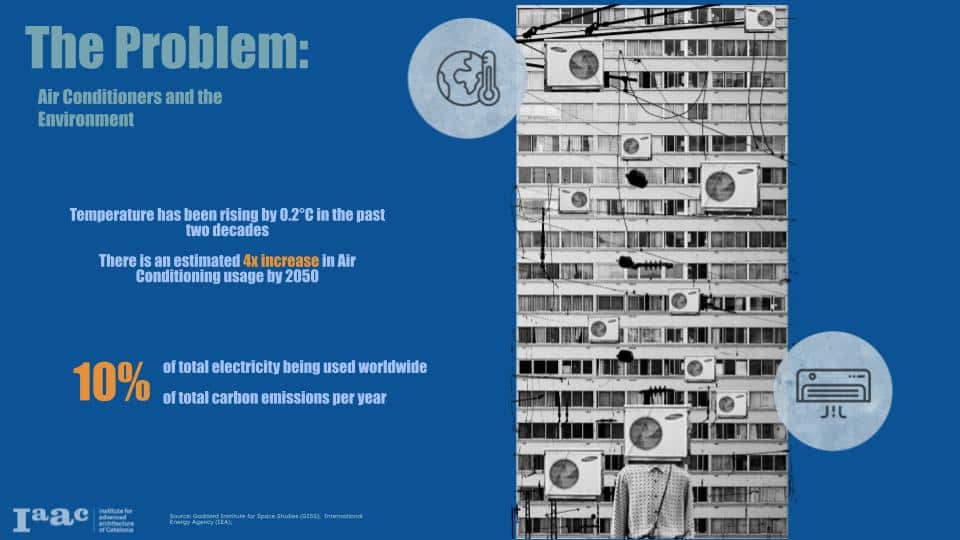
With rising temperatures around the globe, air conditioning is becoming more and more prevalent as an option to keep ourselves cool. However, the overconsumption of air conditioning can have a major effect on the planet as well as the human body. In some areas in the world, summers are cooler and therefore do not need excess air conditioning. Relieving the stress of energy consumed by air conditioners will not only help the planet, but also help the consumer, as with rising demands for cooling solutions, energy costs will continue to rise.
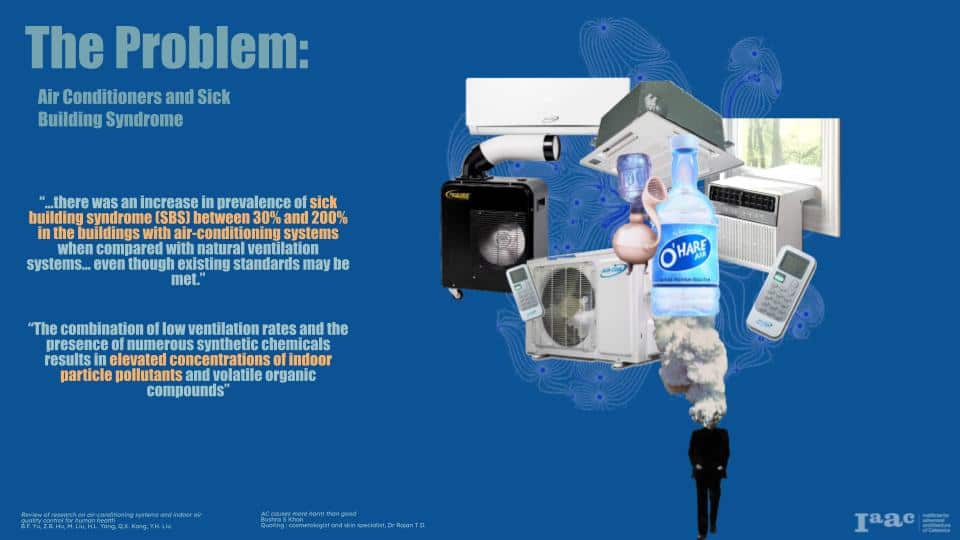
Over usage of air conditioning, other than being bad for the planet, is also not good for the human body. There has been a rise in Sick Building Syndrome, where the building makes us feel sick, or contributes to longer sickness, due to the lack in ventilation. Many people think of pollutants being outdoors, however there are pollutants and chemicals that are within the paint, wall, carpets, cleaning sprays and ceiling tiles are being inhaled indoors at larger rates when we do not have proper ventilation. Central air conditioning found within many office buildings and homes within the United States keep the same air circling and do not help to diffuse these chemicals from the materials the building is made from. Therefore introducing a system that enhances natural ventilation can help with lowering these quantities that we are inhaling and help ourselves breathe better.

With summer temperatures increasing it is important that places with extreme heat have access to air conditioning. However, places that experience cooler summers (less than 35C) have options on cooling within these warmer months. Humans have extremely moist skin, and sweating is the bodies first defense against the heat. Wind flow helps cool our bodies when we sweat since it is able to pull the moisture from the skin allowing the skin to have more space to continue to sweat. Therefor, until the temperature outside is more than 35C (or 95F), the wind will have a cooling sensation on the body either from the evaporation of sweat or from heat transfer of the temperature outside to our skin. This gives an option in areas that have summers under 35C to cool with the wind.
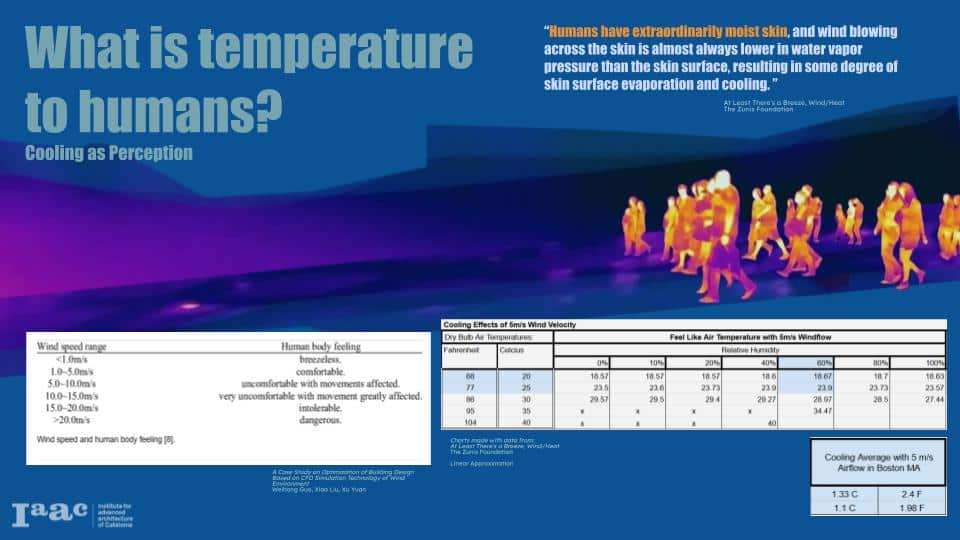
Similarly to how shade feels cooler than temperature in the sun, even though the air temperature outside is the same in both places, wind has a similar effect. In the winter, wind-chill is used to predict how the speeds of wind affect the perception of coldness on the human body. This can be applied within the warmer months as well, just in lower quantities. Within Boston MA, the summer months typically reside from 20-30C (68-86F) with an average 67-74% Relative Humidity. Wind velocities primarily come from the South-West at about 5.3m/s (11mph). Assuming the wind velocity and cooling have a more linear correlation, it can be predicted that at 5m/s, the average summer windspeed in Boston MA, the body will feel about 1C – 1.3C cooler with the wind flow at certain temperatures with a 60% Relative Humidity. This can greatly reduce the need for air conditioning by extending the timeframe in which we can be cool without it.
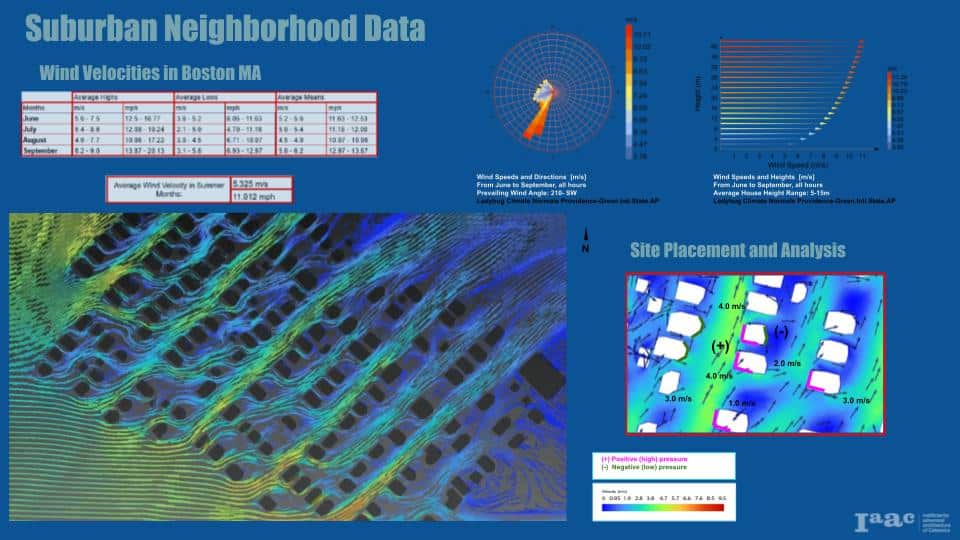
Within neighborhoods, the wind flow hitting the house is not 5m/s due to the additional buildings around and the design of the streets and neighborhood. Wind speeds at ground level are much slower due to such obstacles and therefore exhibit turbulent flows, which are chaotic non linear flows. Therefore it makes it hard to predict exact speeds and directions within certain crowded spaces. Knowing this, designing for the wind means understanding pressures and wind patterns. High pressure zones are when air is hitting a surface and applying pressure upon that surface, low pressure zones do not have air pressing against them and therefore pull air towards them. High pressure zone are found where air first meets the building, and low pressure is found in the back. Wind also likes to flow in a straight line, since it is fastest when going straight. This is why cross ventilation is most effectful since the air can enter and find where to exit faster and smoother than single sided ventilation, where it must compete with itself for the same entrance/ exit. There is nowhere for it to go in this case. Many American homes only have one window per room, prioritizing light gain over air flow.
Therefore understanding what wind needs, and how pressures attract wind is critical in increasing airflow indoors since airflow within neighborhoods is already slower than the average.

Since air conditioning is relatively new, researching ancient methods of cooling and passive ventilation systems from around the world is crucial. These became design influencers in how to merge tactics to fit a new climate. Venturi Effect, the increase in velocity of air after traveling through small spaces, has been used in several cultures as well as angling these perforations for added control of airflow directions. Angles also cause pressure changes as found through studies in the Philippines, that can pull passing air into the home. Skywells, courtyards and wind towers also work with low pressure to pull air out of the home. This increases airflow coming in, as there is an exit point for the air, as well as helping to clear stale warm air that rises out of the home. The addition of plants or water systems has been used in many cultures to help to add to cooling through evaporative cooling.
Positioning of airflow devices was also researched and it was found that most ceiling fans have been placed in areas where humans do not sit or congregate and therefor humans do not benefit from the effects of them. Therefore the placement of openings or airflow elements matching with areas of high usage or furniture placements is important as well.

The cumulation of this research and earlier testing led to the Scoop Design iteration. It takes into effect many of the systems used in vernaculars across the globe. The two room study was placed in line with the South-West summer winds, and the corner was elongated to get the most surface area in this direction to allow more airflow into the home. In previous studies conducted with a laminar flow water table, it was found that an open corner is best for collecting airflow, as straight elements create an area of intense high pressure that acts as a barrier, making it harder for air in enter from the sides. This was to be avoided, therefore two corners were pulled out to create corner openings that were perforated with many openings. This aided in catching the airflow, as well as speeding up its entry into the interior space such as the Jaali in India does. Angled walls with windows placed on both sides, not only fragment the corner into a vertical corner, but use the same methods of pressurizing that are found in the Philippine home that was studied. An airshaft on the top of one of the swoops was also added to pull out any heat that had risen to the ceiling and a back swoop was placed that allowed an exit point for the air. This means it has plenty of places to exit, meaning more airflow can enter. The corner “swoop” windows also allow for airflow to be in areas where furniture would most likely be placed, along the sides of the room.
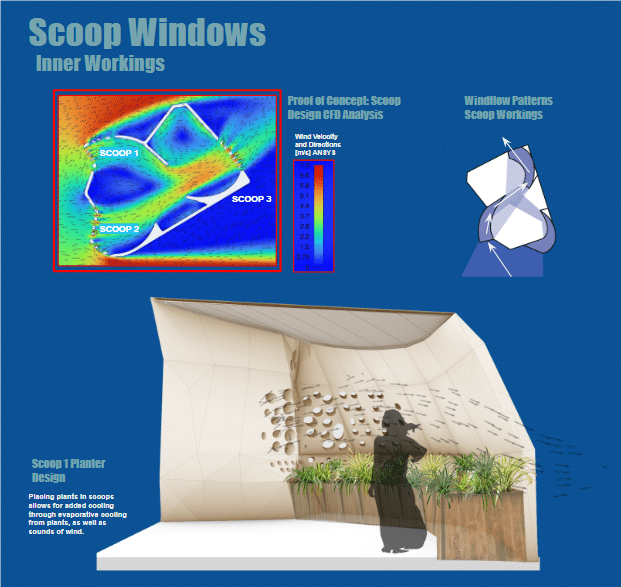
Within the scoop windows, a plant bed was placed which allows for added evaporative cooling from the plant leaves. The wind flowing across the plant’s leaves also create sounds that give the sensation of cooling. This type of cooling through sounds was used within the Alhambra in Granada Spain. There water channels were placed throughout the garden spaces that not only aided in evaporative cooling but also in the mind through sounds that we correlate with cooling sensations. Plants being at the entrance of wind flow into the home also helps to filter pollutants that may enter from outdoors.
Wind Tunnel Tests of Scoop Design.
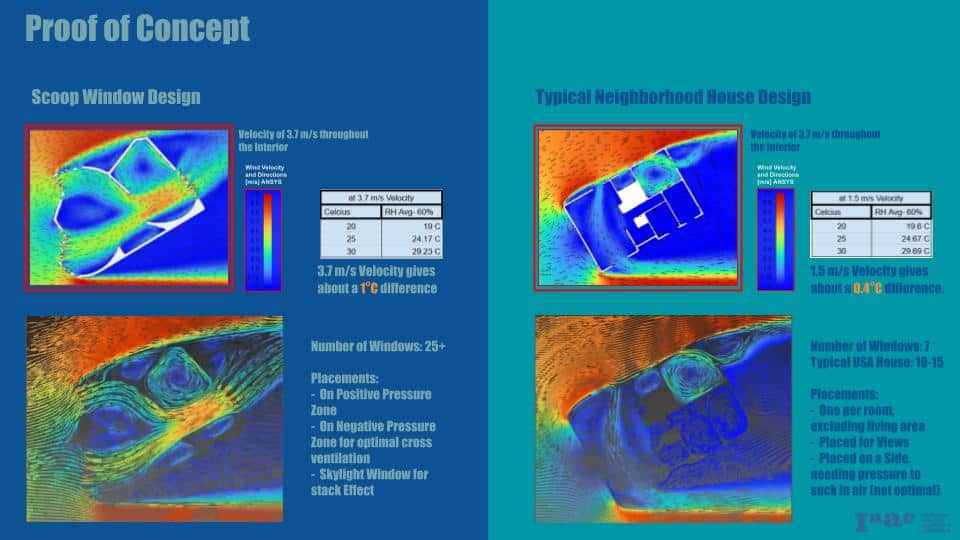
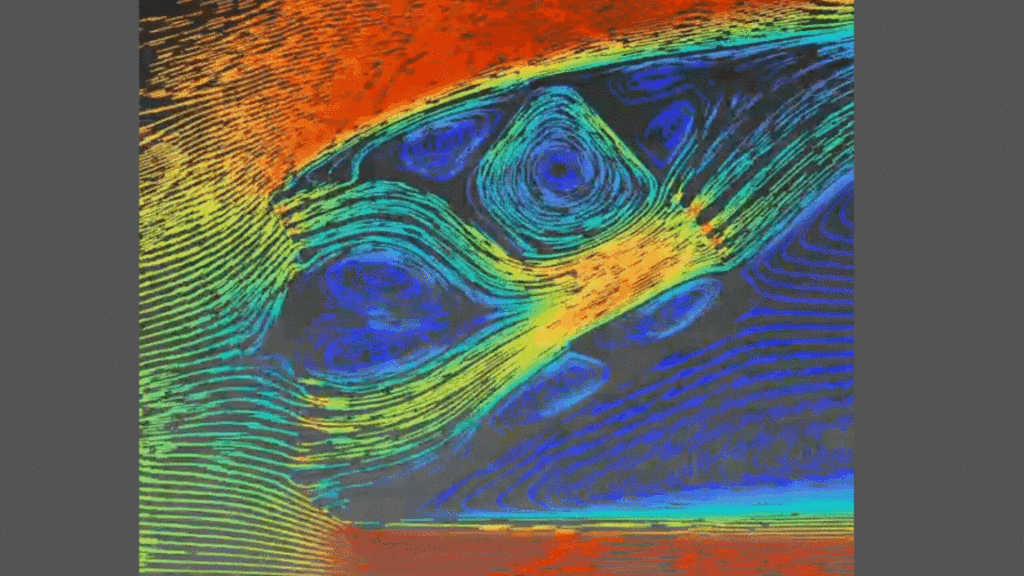
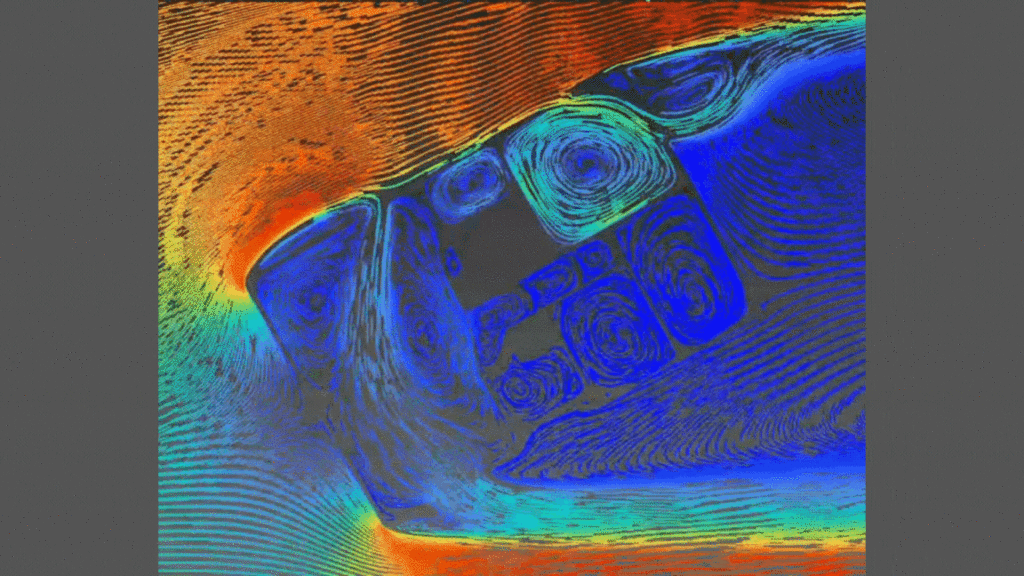
To compare the interior workings of this design to a typical home, a Raised Ranch home design was chosen. This is one of the most typical home types found in the United States and is one that is incredibly common within neighborhoods. It typically has 7-10 windows, while the average American home has 10-15 windows depending on how many stories it has. The Raised Ranch has one story, with a built in basement that is sometimes used as a secondary story for bedrooms or an extra living room. Within this home, many bedrooms have only one window, designed for views and light, not air flow.
In comparison to the wind designed home, 2x the interior airflow was achieved in the Scoop Design, and therefore the cooling average was also 2x more with an average of 1C difference in the Scoop design, in comparison to 0.4C average cooling effect in a normal home. However this effect would only be found in the center of the living spaces, and not within bedrooms, hallways or any other spaces of the typical home.
With the introduction of plants into the scoop design, the cooling average is expected to decrease due to the added cooling through evaporation of water from the plant leaves.
Fabrication Techniques
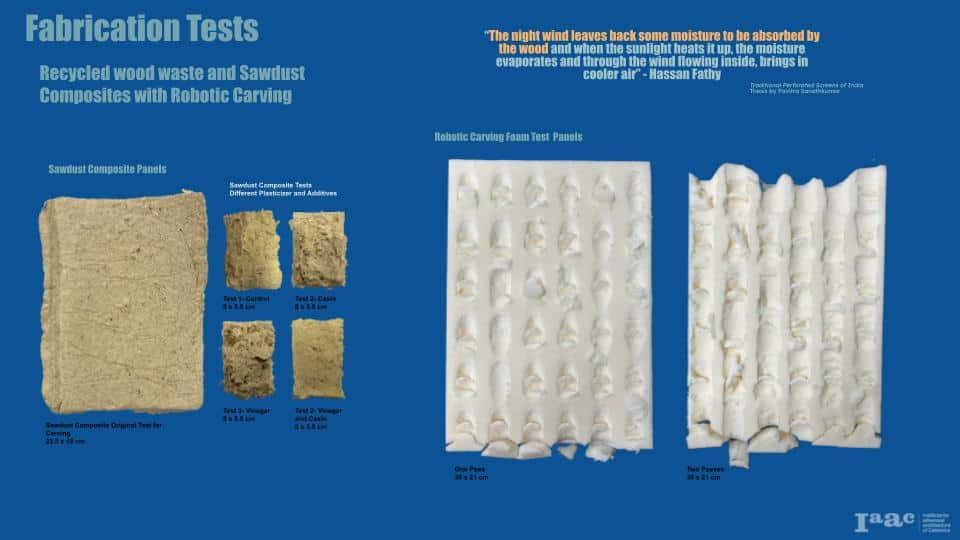
When increasing airflow, material matters. Typical homes within the United States are made from wood, meaning that there is a lot of waste product from harvesting, milling and creation boards to be built with. Wood is also a cellulose based material meaning it is able to absorb water. In other cultures this was used as a design driver for certain elements of the home that were built with wood only to catch the morning dew, helping to cool the air before entering the home.
Sawdust composites were experimented with as a waste material being able to be used as a way to capture moisture and cool airflow. Making sawdust composite panels with biomaterials also ensures a healthy material that air is passing over when it enters the building, alleviating some of the Sick Building Syndrome mentioned.
Sawdust composite board is also incredibly lightweight and easy to carve, meaning that intricate geometries can be explored and enhanced by robotic fabrication. This was experimented with Robotic Carving. The first iterations were done with foam to test toolpaths and tools and with success will be experimented with sawdust composite panels and other wood based materials.
One pass Robotic Carving with Foam
Two passes with 180 degree rotation Robotic Carving with Foam

